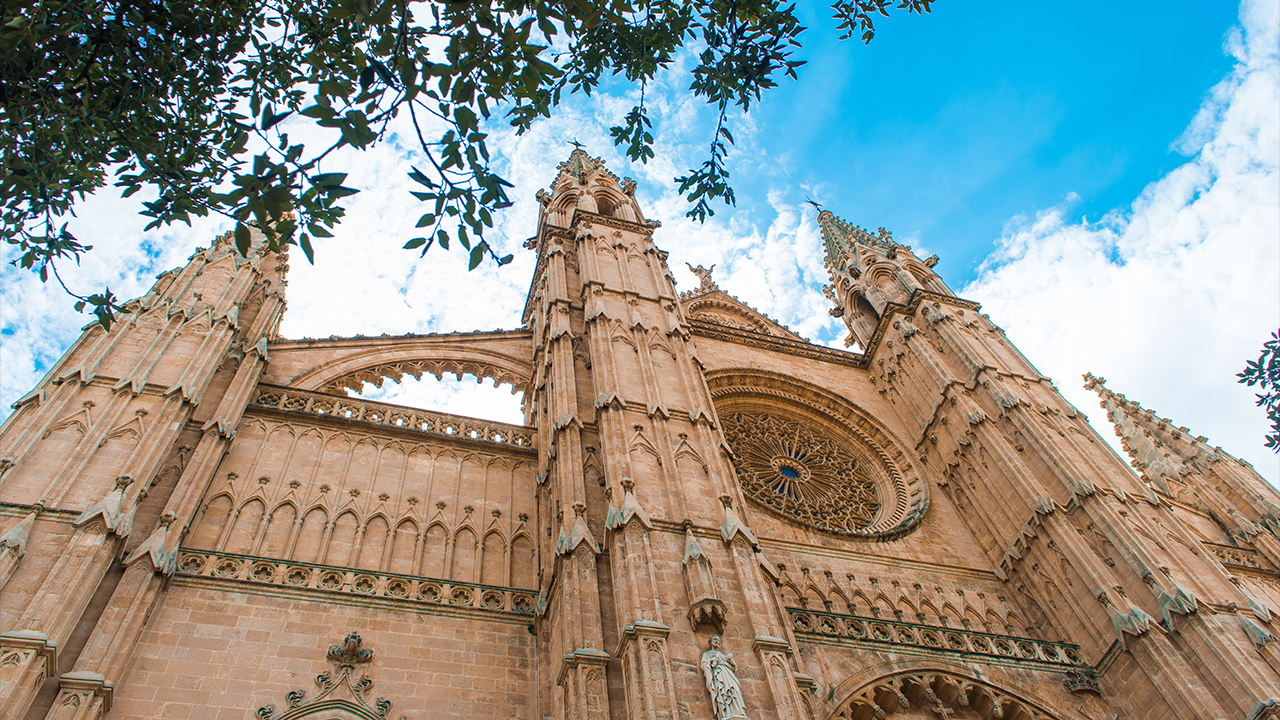La Seu: The Majestic Cathedral of Palma by the Sea
Overlooking Palma Bay, just a few steps from the Mediterranean, rises La Seu, the imposing Catedral de Palma. This majestic Gothic temple, one of the city's most recognisable icons, combines history, architecture and spirituality. Its construction began in 1229 by order of King Jaume I, after conquering Mallorca, fulfilling a promise made to the Virgin for saving his fleet from a violent storm at sea. Since then, La Seu has become a symbol of Palma and of the Christian faith on the island.
o plan your visit, you can check schedules and ticket prices on the official website of the Catedral de Palma. Some tickets include guided tours, allowing visitors to explore the history, art, and secrets of La Seu, accompanied by experts who explain every corner of the temple and its terraces.

History and construction of La Seu
Although Jaume I ordered the consecration of a temple in 1229, for years the old mosque converted into a Christian church was used. It was not until the reign of his son, Jaume II, that construction of the new Gothic cathedral began, starting with the Royal Chapel, where the remains of monarchs of the former Kingdom of Mallorca rest today. Construction continued over three centuries, culminating in the consecration of the temple in 1601, with multiple renovations enriching its architecture.
La Seu stands out for its basilical floor plan, typical of Levantine Gothic, with three naves supported by very tall pillars. The central nave reaches 44 meters in height, one of the tallest among European Gothic cathedrals. Its 87 windows and seven rose windows allow natural light to flood the interior, earning it the nickname the “Cathedral of Light.”
Art and architectural details
The interior combines Gothic and Baroque elements, especially visible in the altarpieces of its 16 side chapels. The Corpus Christi altarpiece, by Jaume Blanquer stands out, depicting the Last Supper. Among the entrance portals, the Portal del Mirador, facing the sea, impresses with its 15-meter pointed arch and low-relief of the Last Supper. The Portal de l’Almoina, on the opposite façade, features an angel by Guillem Sagrera, while the Portal Mayor, Renaissance-style and completed in 1601, is crowned by the Immaculate Virgin and her 15 Marian symbols.
The Rose Window: The Eye of Gothic
The jewel of La Seu is its spectacular main rose window, 13.8 meters in diameter, considered the largest Gothic rose window in the world. Known as the “Eye of Gothic,” it was built in the 16th century above the main altar and is composed of 1,236 glass pieces forming a Star of David. Its smaller counterpart on the Poniente façade creates a unique light phenomenon twice a year, on the 8th of the Cathedral, when sunlight projects a rainbow across the central nave—a spectacle that attracts thousands of visitors.
Interventions by Gaudí and Miguel Barceló
During the 20th century, Antoni Gaudí worked on the cathedral, redesigning the choir, stained-glass windows, and the altar canopy, although some projects remained incomplete. In 2007, Miguel Barceló, a Mallorcan artist, renovated the Chapel of the Blessed Sacrament with an impressive polychrome ceramic mural inspired by the miracle of the loaves and fishes, which has become one of La Seu’s most notable modern attractions.
Museum, Terraces, and the Royal Mausoleum
From May to October, visitors can access the terraces to enjoy panoramic views of Palma and its bay. The Cathedral Museum, located in the Casa de l’Almoina, houses collections of painting, sculpture, and goldwork. The Trinity Chapel serves as a Royal Mausoleum, where the remains of Jaume II and Jaume III rest. The cathedral’s organ, with 3,736 pipes, fascinates music lovers and can be heard during the International Organ Festival.
Where to stay near La Seu
To experience La Seu i comfortably and stylishly, there are two exceptional options in Palma
For those looking for a boutique hotel in Palma's old town, Posada Terra Santa is the perfect choice. Its historic charm and elegant décor reflect Mallorcan tradition, offering a peaceful retreat in the city center.
Alternatively, if you prefer a luxury aparthotel in the centre of Palma, Samaritana Suites combines modern, comfortable spaces with all amenities for an exclusive stay.
Both accommodations are a 10-minute walk from the cathedral, allowing visitors to explore La Seu and enjoy Palma at a relaxed pace, appreciating every detail of this architectural jewel and the beauty of the historic center.

